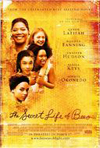2008
Main Movie
Page
Atonement
Boy in the Striped Pajamas
Brideshead Revisited
Counterfeiters
The Dark Knight
Enchanted
Frozen River
Indiana Jones and the Kingdom of the Crystal Skull
Iron Man
Juno
Man on Wire
Michael Clayton
No Country
for Old Men
Rachel Getting Married
the Savages
The Secret Life of Bees
Sweeney Todd
There Will Be Blood
The Visitor
WALL-E
Film
Reviews from 2007
Film Reviews
from 2006
I remember reading Sue Monk Kidd’s bestselling novel five years ago. Her story of a motherless South Carolina girl who escapes her abusive father and gradually experiences healing is warm and inspirational. I loved it for its Southern blend of wisdom, humor, community, feminism, and spirituality. I was glad to hear that it was made into a movie and looked forward to it. While not bad, I found the movie somewhat disappointing. The film version of The Secret Life of Bees is sweet, but never especially engrossing or memorable. It’s like a Lifetime television network movie. Dakota Fanning gives a good performance as young Lily. It’s great to see her mature from childhood to adolescent roles with grace and skill. Along with her maid, Rosaleen (Jennifer Hudson), she leaves her abusive father and, following a clue left by her mother, finds the eccentric African-American sisters, the Boatwrights. August Boatwright (Queen Latifah) is the head of the family which harvests and sells honey in their Pepto-Bismol colored house. Through the acceptance and love of the sisters and the community around them, Lily begins to heal and find her voice. She also learns more the truth about her mother, Deborah, for whose death Lily feels responsible. An interesting theme in the movie is the difficulty of forming relationships across racial boundaries in a segregated society. Early in the movie, there is a scene in which Rosaleen watches LBJ sign the Voting Rights Act. The seeds of change were planted, but they were far from taking root in the Deep South. A bond develops between Lily and Rosaleen, reflecting a previous bond between August and Deborah. However, due to their social inequality, there is still tension. True friendship requires equality, which was not present in the South in 1964. The film also has interesting religious imagery. Lily finds the sisters’ home through an image of Mary on a label of a honey jar. The Boatwright sisters have a statue of a Black woman which they rescued from the sea and brought to their living room. They call the statue Mary, and see in it the mother of Jesus, even though the statue looks nothing like the Biblical Mary. In their religious ritual, they pray to Mary, and touch the statue to receive strength. It’s an interesting variant on Marian theology, which recognizes the power of Mary in both feminist and indigenous cultures. Mary is an enculturated symbol; she is one of them in the same way that Our Lady of Guadalupe is so identified with the people of Mexico. The Secret Life of Bees testifies to the power of a loving community to bring healing and hope. For this reason, it’s worth seeing. However, as well intentioned as it is, it seems a bit flat. Writer-director Gina Prince-Blythewood doesn’t bring a unique perspective to the film, the way that Sue Monk Kidd’s narrative did so well for the novel. The film adds nothing to the novel. I waited for the “aha”moment in which the movie would come together, but, unfortunately, it never comes. Tom Condon, OP |
The film contains some profanity and crude language, racial epithets and violence, nonsexual child abuse, light underage sensuality, murder and suicide; it's acceptable for older teens The USCCB Office for Film & Broadcasting classification is A-III -- adults. The Motion Picture Association of America rating is PG-13 -- parents strongly cautioned. Some material may be inappropriate for children under 13. |
subscribe to
DomLife.org and receive a free email update every two weeks. unsubscribe |



 The Secret Life of Bees
The Secret Life of Bees